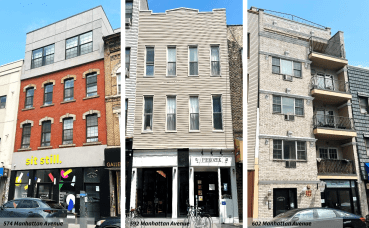For Columbia Expansion Appeal, State Looks to Atlantic Yards
By Eliot Brown May 5, 2010 10:24 pm
reprints Columbia University’s proposed 17-acre expansion is set for a test June 1, when the state’s top court is scheduled to hear arguments on the use of eminent domain, a power that was ruled unconstitutional by a state appellate court in December in a humiliating blow for the Ivy League school and the state. (The scathing court decision labeled the state’s argument that the area was blighted as “mere sophistry.”)
Columbia University’s proposed 17-acre expansion is set for a test June 1, when the state’s top court is scheduled to hear arguments on the use of eminent domain, a power that was ruled unconstitutional by a state appellate court in December in a humiliating blow for the Ivy League school and the state. (The scathing court decision labeled the state’s argument that the area was blighted as “mere sophistry.”)
Seeking to reverse the decision, the state’s lawyers are arguing that the appellate court was far off-base, and ignored precedent set by the top court in November for the use of eminent domain for Atlantic Yards, the $4.9 billion housing and basketball arena project in Brooklyn.
Both sides–the state’s development agency (funded by Columbia for this case), and landowners Nick Sprayregen and Gurnam Singh–have now submitted their briefs, and here’s a look.
Among other arguments, the state asserts that the appellate court tossed aside precedent and was erroneous in suggesting the West Harlem neighborhood was not blighted. From the state’s brief:
“The plurality opinion in the Appellate Division, written by Justice Catterson (and joined in by Justice Nardelli) wholly ignored the decision of this Court issued nine days earlier.
…
The plurality disregarded overwhelming evidence that the Project Site is blighted. Three independent neighborhood conditions studies all documented evidence that numerous buildings in the area are in poor condition as a result of structural deterioration, years of neglect, and environmental and other insanitary conditions.
…
In contravention of decades of this Court’s precedents, the plurality held that it was error for ESDC to even consider underutilization of the Project Site; yet the underutilization methodology ESDC used here as one factor in its assessment was precisely the same methodology it used in the blight study for Atlantic Yards.”
Mr. Sprayregen, one of the two landowners appealing, argued in his brief (posted on his Web site Endeminentdomainabuse.com) that the Columbia project was indeed quite different from the Atlantic Yards case (Goldstein v. NYS Urban Development Corp.), particularly on the issue of blight. Whereas Atlantic Yards was to be built in part over a large set of railyards, Mr. Sprayregen’s attorney, Norman Siegel, argues that Columbia created the blight, a contention he backs up with a “No Blight” study of his own.
This, he argues, sets it apart.
“This Court’s statement in Matter of Goldstein v. New York State Urban Dev. Corp. that the parties’ difference in opinion as to the existence of blight offered just “another reasonable view of the matter,” was a finding based only on the record presented in that case. 13 N.Y.3d 511, 526 (2009). The record in this case is dramatically different. The petitioners in Goldstein did not submit a factual record.
…
On this record, Petitioners-Respondents’ have shown that, because of the intentional and systematic bias with which they were designed and implemented, Respondent-Appellant’s finding and the studies on which it is based, are patently unreasonable and utterly without basis.”
Much more in both briefs, which are here.
ESDC Appellant_Brief to Court of Appeals_3!8!10


